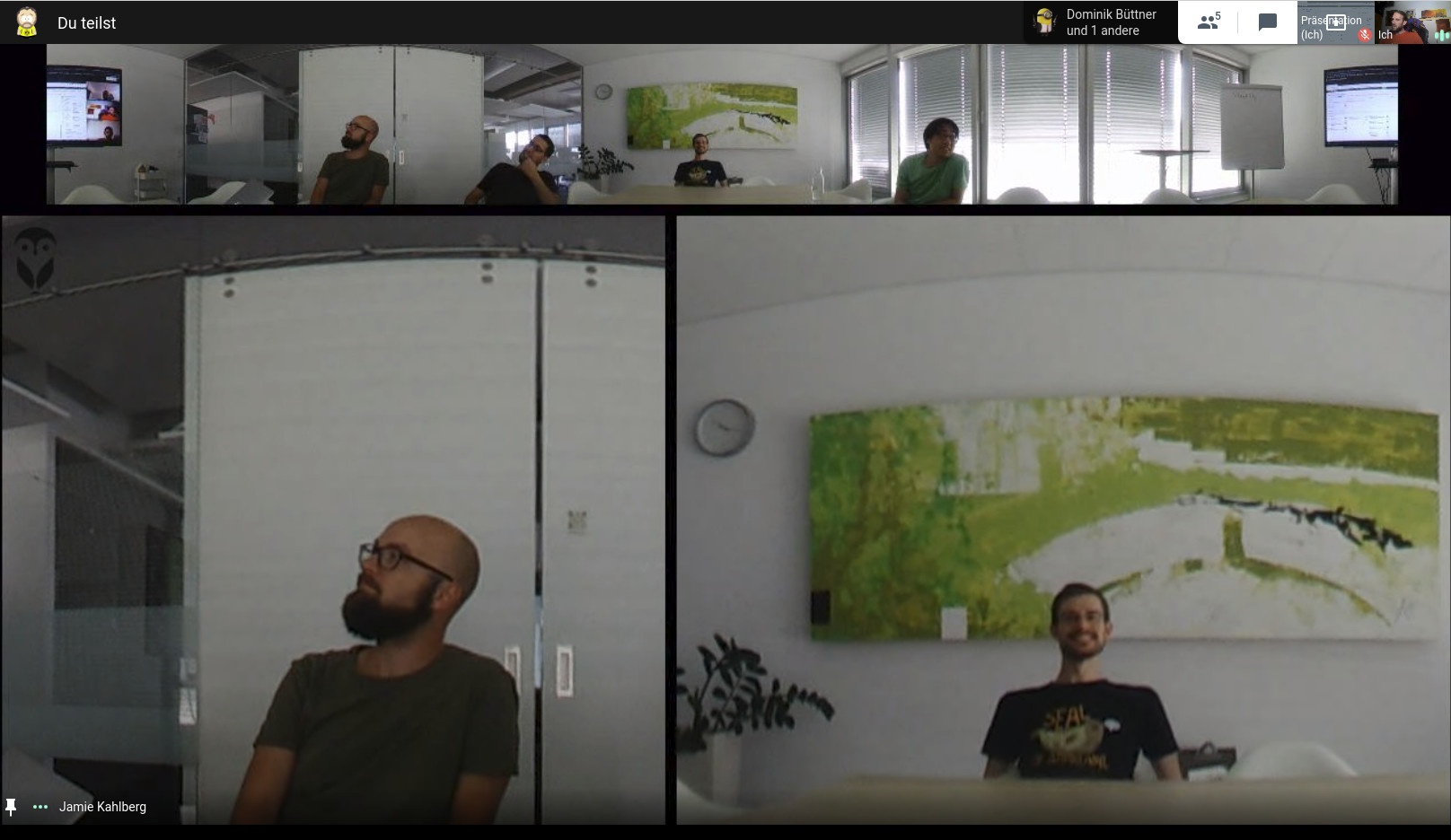Lesen Sie diese Seite auf Deutsch
Several of our teams are always looking for ways to improve remote integration – getting colleagues who work remotely more involved and removing any obstacles in their way. The most important use case here is the participation in meetings and calls, and of course, integration is not just a question of software but hardware, too. I already mentioned our newest addition in my last blog post on this topic – the Meeting Owl!
At Scrum Day 2019, one of the other visitors told me about this new device but I forgot to follow up on it. Luckily, it came back to mind during a meeting and in a spur-of-the-moment move, a colleague ordered it from our IT department.
This weird and wonderful bird has been in our office for a few weeks now. But what can it do?
The value proposition: visual and acoustic room coverage
The Meeting Owl is primarily conceived for use in "table meetings" where the participants all sit around one table. It has a 360° camera lens, so it's able to capture images of the entire room on all sides. Moreover, it includes eight built-in, omnidirectional microphones, each of which has a 3.5-meter range. The speakers are also integrated and distribute the sound in all directions while avoiding echo.
The real highlight is the "control center" at the foot of the owl, which is equipped with a processor including its own AI. In addition to the 360° view, in automatic mode, it also shows the person speaking (as well as the person who spoke last). But there is also a manual mode, in which you can control the camera focus via an app. (Unfortunately, it only works with Bluetooth and not from a distance.)
And so comes the most important question: How much does it cost? It's available on Amazon for around 800 US Dollars, but then you might have the customs duties on top. But then, that's it. There aren't any recurring license fees or anything like that.
So that's the theory, let's look at it in practice.
The initial tests
To test it out, we moved our daily standup to one of our meeting rooms. This enabled us to make use of our colleagues' expertise in the I.T. department for the first steps.
Straight away, I noticed how cool it was to be able to see everyone at the meeting as an external participant. Otherwise, you're only able to see the people that are sitting within the camera's range. That alone makes for a significant improvement in comparison to its predecessor.
Furthermore, the focus on the person speaking works quite well, even if the large image isn't in HD quality – however, it is Google Meet that sets the boundaries in this case. The Meeting Owl doesn't only try to show the person speaking in the correct part of the shot but it also zooms in on their face a little. Pretty cool!
The sound from the microphone came across really well and I could understand everyone very clearly. (But Google Meet could also be a limiting factor here too). My colleagues were able to understand me well too (acoustically, at least).

Our Meeting Owl worked well in the meeting room and improved integration.
The second testing ground was our team room, which is where our daily standup usually takes place, as do a number of everyday use cases for the Meeting Owl. In the team area, the 360° effect isn't quite as advantageous because depending on its location only 180° is actually interesting for the viewer. Here, it would make sense to use a more central location – but this would turn the Meeting Owl into a real tripping hazard. The distance between my colleagues and the Owl as well as the noise made by people passing our room proved confusing for the Owl's AI at times. We will have to do a few more experiments here.

We need to keep experimenting in the team area. The size of the room and background noise confused the Owl at times.
The third test took place in our library, another (smaller) meeting room. In this case, the Meeting Owl was able to boast its full potential. When you place the device in the center of the room, the autofocus works fantastically and all of the participants are closer up. This applies to both the larger image and the sound. The view of the entire room is great and as a "remotee" you certainly feel more involved in the meeting.

Everything worked perfectly in the "library" and as a "remotee" you feel like you're there in the room.
A helpful asset when conventional technology reaches its limits
With all its functions, the Meeting Owl is a great addition to our remote setup. Of course, as is often the case, the theory (or the marketing) promises a little more than it delivers in practice (or has until now). But the extent of its benefits is highly dependant on the use case and operational scenario.
In a meeting, in which all of those present are within the range of a normal camera, it doesn't make that much sense to combine the room view and focus. If a classical setup is practical and working well for you, the Meeting Owl probably won't offer any additional benefits – quite the opposite. The user experience for external participants is quite strange owing to the fish-eye lens. But when a classic setup reaches its limits, the Meeting Owl can really show its strengths.
We will continue to experiment with it. I'll come back to share our experiences with you again soon! 🙂
Further information
Remote meetings: Open-mindedness and willingness to experiment leads to better results
Agile remote transition I: why?
Does a distributed Workplace Work? Well, It Depends


